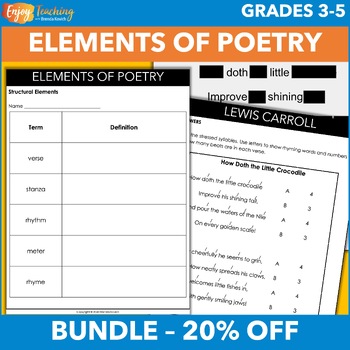Poetry Elements Unit - Genre Study for Third, Fourth, and Fifth Grades
- Zip
- Internet Activities
- Easel Activity

Products in this Bundle (4)
Description
Teach elements of poetry with confidence! This genre study focuses on structural elements and sound devices. Kids annotate classic children’s poems to indicate verses, stanzas, rhyme, rhythm, meter, onomatopoeia, personification, and alliteration.
Open the previews to take a closer look at the parts of this bundle.
1. Teach structural elements of poetry with a fun mini lesson. An age-appropriate ELA slideshow explains verse, stanza, rhythm, meter, and rhyme. Students take notes on key vocabulary. Then they annotate “Twinkle, Twinkle, Little Star” to apply their knowledge.
2. Reinforce structural elements with a colorful anchor chart, handouts, and brief matching quiz.
3. Ask kids to identify structural elements and sound devices in the work of three classic children’s poets. Literature and activities scaffold from simple to complex.
- The nonsense poetry of Lewis Carroll gets them started. They annotate, compare, and explore meter. As a bonus, the whole class can memorize a poem with Poetry Blackout.*
- The limericks of Edward Lear provide a specific structure to explore. Students also identify onomatopoeia. As an extension, they can memorize with Poetry Blackout.*
- With Amy Lowell’s traditional poetry, students identify personification, onomatopoeia, and alliteration, as well as the refrain. You may also discuss how rhythm enhances the overall effect.
4. As an extension, memorize a poem! A set of Google Slides presents a poem, which third, fourth, or fifth grade students read aloud. As the slides progress, more and more words are covered, and the piece is read again and again. Within minutes, kids have memorized it!
Files include everything you need to teach elements of poetry (and plenty of practice):
- Instructional slideshow with “Mary Had a Little Lamb” (PowerPoint and Google Slides versions included)
- Guided practice with “Twinkle, Twinkle, Little Star”
- Anchor charts, handouts, and quiz
- Annotation activities with “How Doth the Little Crocodile” and “Tweedledum and Tweedledee” (Lewis Carroll), the limericks of Edward Lear, and “The Trout” and “Wind” (Amy Lowell)
- Opportunity to compare the structure of a poem with its parody
- Extensions – meter activities and Poetry Blackout
Resources in this unit can be used in a variety of ways in your classroom or homeschool.
- Present as a full-blown unit of study.
- Pick and choose activities.
- Spread throughout the year.
Printable and digital versions of each worksheet are included.
- A PDF provides a printable option.
- Easel Activities and Google Slides offer digital versions.
Enjoy teaching ELA!
Brenda Kovich





